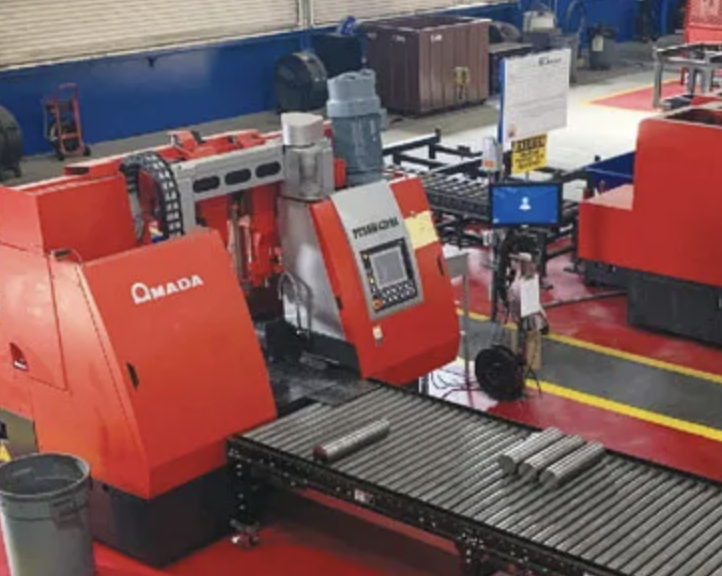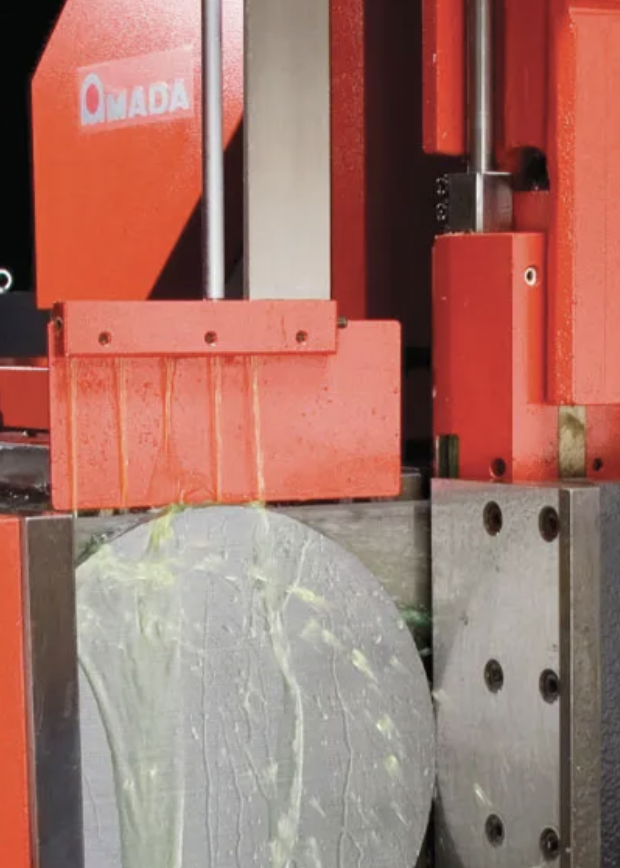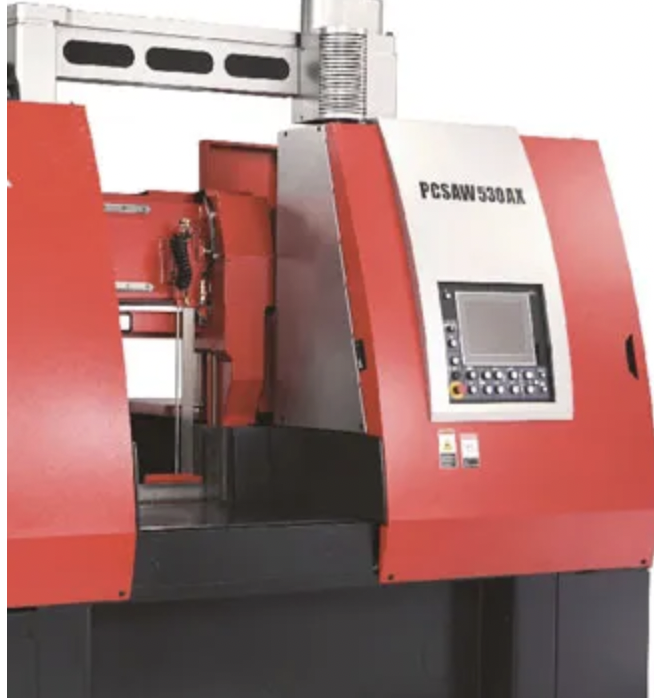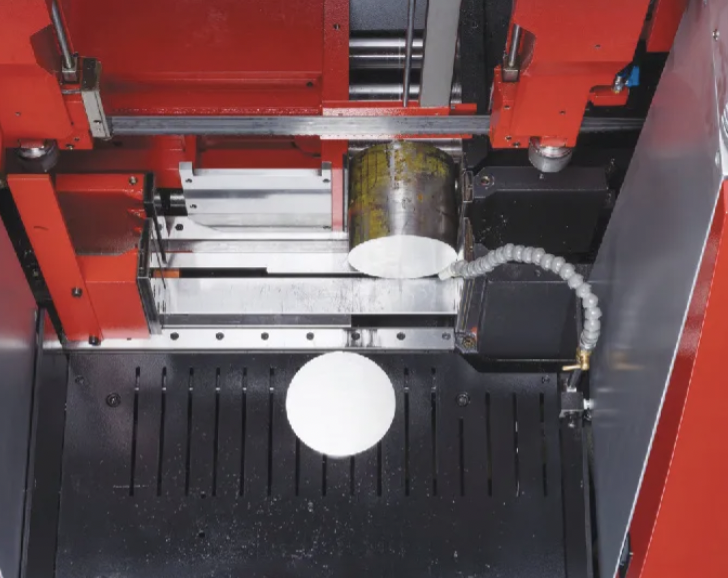Specialty metals supplier boosts productivity with pulse cutting technology


Above: The Amada PCSAW430AX and PCSAW330 are two of the pulse cutting band saw models that TW Metals operates. Amada reports that the pulse technology reduces sawing resistance to dramatically improve cutting rates.
April, 2023- Specialty metals supplier boosts productivity with pulse cutting technology
TW Metals LLC is a specialty metals supplier that has roots dating to 1907, a year when Teddy Roosevelt was U.S. president and an outbreak of bubonic plague hit San Francisco. Headquartered in Exton, Pennsylvania, TW Metals has 18 U.S. stocking locations and 11 more across the globe.
When the company began supplying more metal to a major aerospace OEM and its affiliates nearly nine years ago, TW Metals was compelled to upgrade many of its band saws to tackle the challenging aerospace-grade materials, says Barry Benjamin, director of field operations. Those materials must withstand high levels of heat, extreme oxidation and cycling, and include nickelbased superalloys, such as the various grades of Inconel, Hastelloy and Monel. “Traditional saw technology worked, but it was just taking longer than we wanted.”
TW Metals has worked with Amada Machinery America Inc. in Brea, California, for more than four decades, and the machine tool builder introduced the service center chain to its pulse cutting technology. According to Amada, pulse cutting technology reduces sawing resistance to dramatically improve cutting rates.
Intrigued, Benjamin says representatives from TW Metals visited Amada’s training center in Los Angeles and ran test cuts on many of its bar and tube products, compared the square inches cut per minute, the cut quality and tolerance adherence of pulse cutting saws to conventional ones, and saw the significant improvement in production rates that the pulse cutting band saws provide. “The proof was in the pudding,” he says.
MULTIPLE MODELS
Fast forward to the present and TW Metals has 23 machines from Amada’s PCSAW series of highspeed, dual-post saws out of the 35 Amada saws at its U.S. operations, Benjamin says. The pulse cutting models at TW Metals include the PCSAW330 and PCSAW430X/AX, and the Atlanta facility is expecting delivery of PCSAW530AX model soon to cut material up to 20 inches in diameter. Amada also builds PCSAW530X and PCSAW720 models.
On the X version, a hydraulic flow control valve with stepping motor controls the cutting feed, while the AX models use a servomotor control for the cutting feed, Amada reports.
“The AX version provides a controlled servomotor along with a ball screw drive to provide consistent cutting rates on harder materials,” Benjamin says. “When you combine that with the twin-beam design and wider blade width, it creates a very stout cutting platform, allowing us to aggressively attack the harder alloys without deviation or deflection on the squareness of the cut face and giving us a significant increase in square-inch cutting rates compared to conventional saws.”

TW Metals’ Atlanta facility expects delivery of an Amada PCSAW530AX band saw soon
On the softer alloys, a conventional band saw cuts 300 series stainless steel at a rate of about 2 to 3 square inches per minute, Benjamin explains, while a saw with pulse cutting technology cuts that same metal at a higher feed rate, up to 15 square inches per minute or more.
The faster cutting rates result from the combination of the pulse technology and Amada’s Axcela G carbide-tipped blades that have an EX-COAT-DP coating, he adds. The coating provides a high degree of hardness and a high level of resistance to heat and chipping, Amada reports.
When determining which type of blades to purchase, Benjamin says TW Metals tested different blades to see how many square inches of cutting each type could produce and found some exceeded 20,000 square inches before they needed replacement. “Your price per cut is pretty good when you get that kind of blade life.”
Benjamin equates using blades manufactured by the machine builder to effectively maintaining a vehicle’s performance by using parts from the automaker that produced the vehicle. “Amada is going to make sure that their saws run optimally by using the blades that are designed to be cut on them.”
He notes that the pulse cutting saws provide a straightness tolerance as tight as 0.0005 inch per vertical inch, from the top to the bottom of the workpiece, which reduces the amount of cleanup for customers. When a user sets the saw to cut at a specific squareness level, squareness indicators show if the form is deviating from that specification and, if so, the saw shuts off automatically after the final cut so the operator can check it and make any needed adjustments.
CONTROLLED CUTTING
Because TW Metals saws a variety of metals, the company benefits because the CNC automatically provides the optimal speeds and feeds for a specific metal. The CNC contains most if not all the alloys the supplier processes, eliminating any operator guesswork, and specialty alloys can be programmed as needed, according to Benjamin.

The pulse cutting technology on Amada band saws has led TW Metals to boost its monthly output by at least 25 percent.
“If you know your alloy and know your OD, the parameters are set up for optimal cutting,” he says, noting that the ODs range from 0.500 to 16 inches and larger at TW Metals.
In addition, the CNC stores up to 2,700 different jobs, so TW Metals can group customers’ cut parts and/or create job numbers to identify customers’ cut pieces, Benjamin says. “If we’re cutting the same diameter, we can queue up multiple cutting jobs and the saw does not stop until each job has been cut. This saves us a tremendous amount of time by not programming every time.”
While TW Metals continues to convert a lot of its older saws to Amada saws, Benjamin says the pulse cutting saws are not needed at all branches because each branch has a slightly different customer base.
“They’re not all cutting heavy bar, so depending on the application, they don’t always need the bigmuscle machines.”
But when the application is appropriate, such as when sawing high-temperature superalloys, the PCSAW330 and PCSAW430X/ AX models “are our saws of choice,” Benjamin says. “They’re pretty versatile.”
The company cuts up to 16-inch diameter material on the PCSAW430X/AXs and up to 11-inch diameter on the PCSAW330s, he notes. “The sweet spot for our bar work is in the 5- to 6-inch range, so those two sizes can get it done.”
Benjamin estimates that the pulse cutting technology on Amada band saws has allowed TW Metals to increase its monthly output by at least 25 percent. “Doing more with less has enabled TW Metals to ship more processed cut parts daily.”
Amada Machinery America Inc., 847/285-4800, http://amadamca.com/
TW Metals LLC, 610/458-1300, http://twmetals.com/











